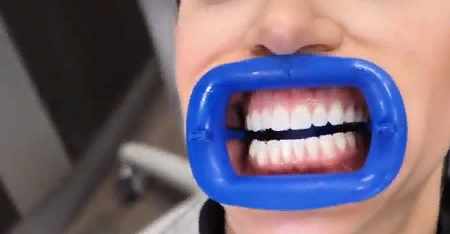Enamel erosion can cause stains, rough teeth, and hypersensitivity. In addition to ruining the aesthetics of your smile, it causes physical discomfort and increases the risk of tooth loss. Enamel erosion affects mostly women over the age of 30, with an overall incidence ranging from 10% to 20%. What are the dangers of the disease, and how can it be managed?
What is Tooth Enamel Erosion
Erosion is known as a non-carious dental disease in which the enamel is gradually destroyed. Distinctive signs of the disease are characteristic white, yellow or brown spots on the front of the teeth and depressions on the surface of the enamel. If the disease is left untreated, it will gradually destroy not only the outer shell of the tooth, but also the deeper layers of the tissue. What are the distinctive signs of erosion other than changes in the color and integrity of the teeth? As the disease progresses, the enamel becomes rough, prone to decay. In addition, there is tooth hyperesthesia – sensitivity to cold, hot, sour and sweet. These stimuli cause acute, short-term pain.
There are three stages of the disease in total. In the initial stages, only the top layers of enamel are damaged, while the second stage involves the opening of the enamel-dentin interface, and the third stage involves the dentin itself. The result is a thinning of the hard tissue of the tooth and a high risk of losing it.
Causes of Enamel Erosion
It is difficult to answer this question, because there is no unequivocal opinion as to the causes of enamel erosion. At the same time, doctors consider several options:
- Exposure to chemicals. Assumes regular exposure of the body to chemicals. For example, on people who work in the workplace. It also applies to those who often consume carbonated drinks and simple carbohydrates.
- Mechanical damage. Erosion can be caused by the use of harsh toothbrushes or highly abrasive pastes that negatively affect enamel.
- Endocrine system malfunction. Another possible cause of the disease is a disorder in the endocrine system. An ultrasound examination of the thyroid gland is often prescribed for diagnosis.
Enamel Erosion Removal
For the timely diagnosis of tooth enamel erosion, you need to see a dentist at least twice a year. The difficulty is that the disease may be confused by its external signs with fluorosis or ordinary hardened plaque as a result of poor oral hygiene. You may also need help from related specialists such as an endocrinologist, gastroenterologist, and others.
During the examination, the dentist directs a stream of air at the enamel until it is completely dry or applies an iodine solution. In this way, the signs of the disease become more pronounced. When the diagnosis is made, the doctor prescribes treatment for tooth enamel erosion. This may include:
- Remineralizing therapy – local or systemic. Regular applications of fluoride, calcium and other missing elements are applied to the affected teeth;
- Gentle bleaching – gentle techniques are used, such as ZOOM 4, and the teeth are finished with a protective fluoride varnish;
- Artistic restoration – if the shape and color of the enamel is significantly changed, the appearance of the jaw is restored with composite materials or veneers.
Depending on the cause of enamel erosion, additional examinations and, as a result, more complex treatment are prescribed. For example, in the case of thyroid problems, hormone therapy may be necessary.
Prevention
The first rule is to visit the dentist regularly. Preventive visits are necessary once every six months, unscheduled – when the first alarming symptoms appear. Secondly, it is important to choose the right hygiene products, i.e. toothpaste and brushes. Pay attention to the hardness level of the bristles, it is desirable to take a medium. As for the abrasiveness of toothpaste, for daily use suit means with an RDA not higher than 80 or 90. Finally, don’t forget to use mouthwashes and dental flossers or irrigators for thorough oral hygiene.






